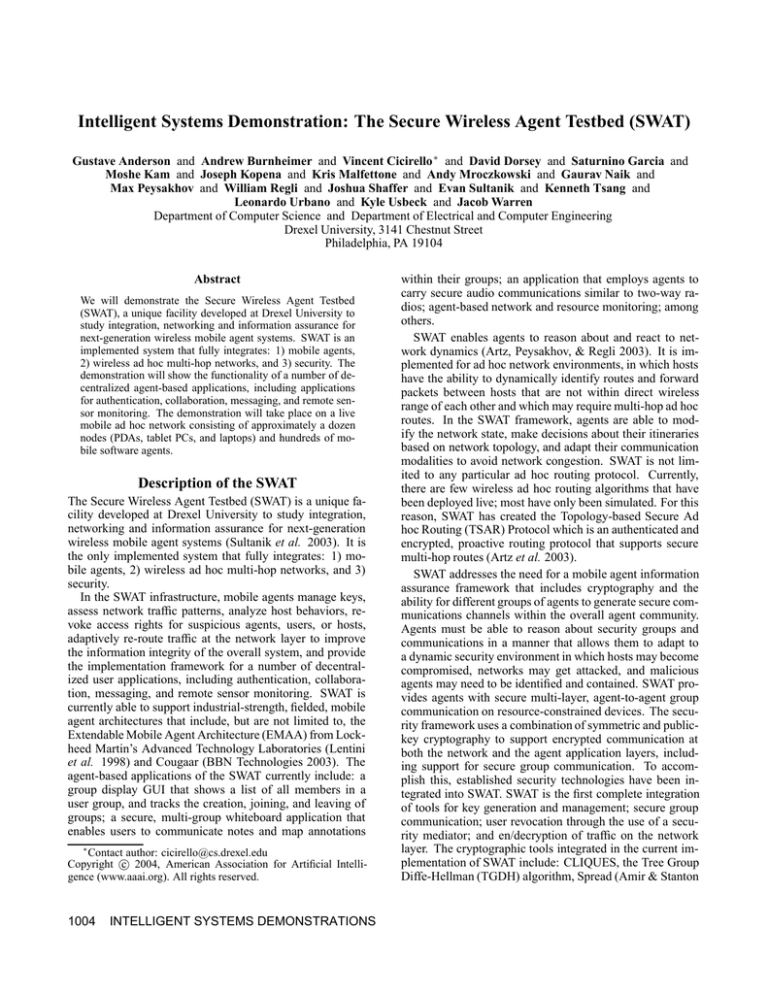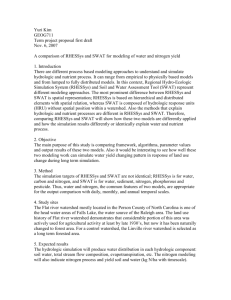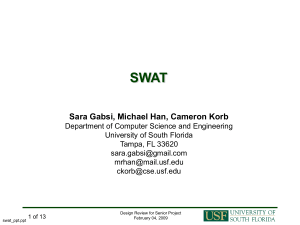
Intelligent Systems Demonstration: The Secure Wireless Agent Testbed (SWAT)
Gustave Anderson and Andrew Burnheimer and Vincent Cicirello ∗ and David Dorsey and Saturnino Garcia and
Moshe Kam and Joseph Kopena and Kris Malfettone and Andy Mroczkowski and Gaurav Naik and
Max Peysakhov and William Regli and Joshua Shaffer and Evan Sultanik and Kenneth Tsang and
Leonardo Urbano and Kyle Usbeck and Jacob Warren
Department of Computer Science and Department of Electrical and Computer Engineering
Drexel University, 3141 Chestnut Street
Philadelphia, PA 19104
Abstract
We will demonstrate the Secure Wireless Agent Testbed
(SWAT), a unique facility developed at Drexel University to
study integration, networking and information assurance for
next-generation wireless mobile agent systems. SWAT is an
implemented system that fully integrates: 1) mobile agents,
2) wireless ad hoc multi-hop networks, and 3) security. The
demonstration will show the functionality of a number of decentralized agent-based applications, including applications
for authentication, collaboration, messaging, and remote sensor monitoring. The demonstration will take place on a live
mobile ad hoc network consisting of approximately a dozen
nodes (PDAs, tablet PCs, and laptops) and hundreds of mobile software agents.
Description of the SWAT
The Secure Wireless Agent Testbed (SWAT) is a unique facility developed at Drexel University to study integration,
networking and information assurance for next-generation
wireless mobile agent systems (Sultanik et al. 2003). It is
the only implemented system that fully integrates: 1) mobile agents, 2) wireless ad hoc multi-hop networks, and 3)
security.
In the SWAT infrastructure, mobile agents manage keys,
assess network traffic patterns, analyze host behaviors, revoke access rights for suspicious agents, users, or hosts,
adaptively re-route traffic at the network layer to improve
the information integrity of the overall system, and provide
the implementation framework for a number of decentralized user applications, including authentication, collaboration, messaging, and remote sensor monitoring. SWAT is
currently able to support industrial-strength, fielded, mobile
agent architectures that include, but are not limited to, the
Extendable Mobile Agent Architecture (EMAA) from Lockheed Martin’s Advanced Technology Laboratories (Lentini
et al. 1998) and Cougaar (BBN Technologies 2003). The
agent-based applications of the SWAT currently include: a
group display GUI that shows a list of all members in a
user group, and tracks the creation, joining, and leaving of
groups; a secure, multi-group whiteboard application that
enables users to communicate notes and map annotations
∗
Contact author: cicirello@cs.drexel.edu
c 2004, American Association for Artificial IntelliCopyright gence (www.aaai.org). All rights reserved.
1004
INTELLIGENT SYSTEMS DEMONSTRATIONS
within their groups; an application that employs agents to
carry secure audio communications similar to two-way radios; agent-based network and resource monitoring; among
others.
SWAT enables agents to reason about and react to network dynamics (Artz, Peysakhov, & Regli 2003). It is implemented for ad hoc network environments, in which hosts
have the ability to dynamically identify routes and forward
packets between hosts that are not within direct wireless
range of each other and which may require multi-hop ad hoc
routes. In the SWAT framework, agents are able to modify the network state, make decisions about their itineraries
based on network topology, and adapt their communication
modalities to avoid network congestion. SWAT is not limited to any particular ad hoc routing protocol. Currently,
there are few wireless ad hoc routing algorithms that have
been deployed live; most have only been simulated. For this
reason, SWAT has created the Topology-based Secure Ad
hoc Routing (TSAR) Protocol which is an authenticated and
encrypted, proactive routing protocol that supports secure
multi-hop routes (Artz et al. 2003).
SWAT addresses the need for a mobile agent information
assurance framework that includes cryptography and the
ability for different groups of agents to generate secure communications channels within the overall agent community.
Agents must be able to reason about security groups and
communications in a manner that allows them to adapt to
a dynamic security environment in which hosts may become
compromised, networks may get attacked, and malicious
agents may need to be identified and contained. SWAT provides agents with secure multi-layer, agent-to-agent group
communication on resource-constrained devices. The security framework uses a combination of symmetric and publickey cryptography to support encrypted communication at
both the network and the agent application layers, including support for secure group communication. To accomplish this, established security technologies have been integrated into SWAT. SWAT is the first complete integration
of tools for key generation and management; secure group
communication; user revocation through the use of a security mediator; and en/decryption of traffic on the network
layer. The cryptographic tools integrated in the current implementation of SWAT include: CLIQUES, the Tree Group
Diffe-Hellman (TGDH) algorithm, Spread (Amir & Stanton
1998), Secure Spread (Amir et al. 2002), a SEcurity Mediator (SEM) (Boneh et al. 2001), and IPSec.
Each host in the SWAT is an integration of the agent system, the network, and security infrastructure. The agent
framework contains both mobile agents, and static agents
(services). The security components of a host include group
key management, and group membership revocation, enforced by a security mediator. The agent framework is connected to the security components, enabling an agent (or
the whole agent system) to join or leave a group, with the
permission to join controlled by the security mediator. The
network components enable secure point-to-point communication for the agent framework, as well as reliable group
communication for the security components. Point-to-point
communication is implemented using standard TCP/IP and
is secured using IPSec. All network communication is
routed through a multi-hop ad hoc routing protocol on a
wireless network.
The SWAT infrastructure consists of PDAs (mostly HP
iPAQs), tablet PCs, and laptops on an 802.11b wireless network with ad hoc routing. SWAT is developed on the Familiar Linux distribution, using the Intel Strong Arm architecture found within the HP iPAQ h3800 series PDAs. A similarly configured Linux environment exists for the x86 architecture, to incorporate other portable devices to the testbed
such as laptop and tablet PCs. SWAT makes use of Cisco
Systems’ Aironet 350 series PCMCIA cards across all platforms. We have selected the Aironet cards based on empirical studies, demonstrating that the Aironet cards have the
best performance in ad hoc mode compared to network cards
of other brands.
Demonstration Scenarios
SWAT is currently being tested and validated in a number of
practical scenarios. The main functional objective of SWAT
is to provide users with tools for distributed, mobile, collaborative work and communication. There are many practical applications of such a system (e.g., police personnel at a
sports event, medical personnel at an accident scene, emergency responders to a natural disaster). One possible SWAT
application may be in the homeland security domain, where
first-responders react to civil emergencies and “bring their
own network.” Using SWAT they will be able to communicate and transfer information more effectively, and in ways
not possible with existing technologies.
Throughout the conference Demo Program, SWAT will
be demonstrated continuously. A demonstration will begin with a large set of hosts in the staging area, familiarizing the audience with the platforms. After a review of
the equipment, we shall demonstrate group functionality
through group creation and “join” and “leave” operations.
Certain SWAT demonstrators wielding wireless components
would leave the area, and demonstrate use of the whiteboard
application. The whiteboard application will also show the
integration of GPS as a backdrop for notations sent to group
members (given adequate GPS radio signal reception inside
the building). Two-way radio communication features will
be used to show coordination, and for demonstrating secure
routing of messages according to group structure. Revocation functionality will be demonstrated through the revocation of agents and users both within the staging area, and
away “in the field”. Streaming video and audio will be
sent from remote hosts to the staging area, and hosts may
be “knocked out of commission” as they suffer power and
network failures. Different host topologies will be demonstrated in order to impose network “stresses” on the routing protocol and on the network-aware reasoning agents. A
Sharp Zaurus handheld PDA will attempt to decipher transmissions and disturb operation of the secure SWAT network.
References
Amir, Y., and Stanton, J.
1998.
The spread
wide area group communication system.
Technical Report CNDS-98-4, The Center for Networking
and Distributed Systems, John Hopkins University.
http://www.cnds.jhu.edu/publications/.
Amir, Y.; Kim, Y.; Nita-Rotaru, C.; and Tsudik, G. 2002.
On the performance of group key agreement protocols. In
Proceedings of the 22nd IEEE International Conference on
Distributed Computing Systems. An extended version is
available as Technical Report CNDS-2001-5.
Artz, D.; Burnheimer, A.; Regli, W.; and Kam, M. 2003.
The topology-aware secure ad hoc routing protocol. Technical report, Department of Computer Science, Drexel University.
Artz, D.; Peysakhov, M.; and Regli, W. 2003. Network
meta-reasoning for information assurance in mobile agent
systems. In Proceedings of the Eighteenth International
Joint Conference on Artificial Intelligence, 1455–1457.
BBN Technologies. 2003. Cougaar architecture document.
http://docs.cougaar.org.
Boneh, D.; Ding, X.; Tsudik, G.; and Wong, M. 2001.
A method for fast revocation of public key certificates and
security capabilities. In Proceedings of the 10th USENIX
Security Symposium, 297–308.
Lentini, R.; Rao, G. P.; Thies, J. N.; and Kay, J. 1998.
Emaa: An extendable mobile agent architecture. In AAAI
Workshop on Software Tools for Developing Agents.
Sultanik, E.; Artz, D.; Anderson, G.; Kam, M.; Regli,
W.; Peysakhov, M.; Sevy, J.; Belov, N.; Morizio, N.; and
Mroczkowski, A. 2003. Secure mobile agents on ad hoc
wireless networks. In Proceedings of the 15th Innovative
Applications of Artificial Intelligence Conference (IAAI03), 129–136.
INTELLIGENT SYSTEMS DEMONSTRATIONS 1005





